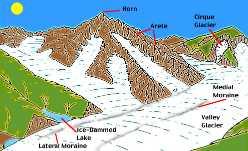CORRIE, CIRQUE OR CWM
- The downslope movement of a glacier from its snow-covered valley-head and the intensive shattering of the upland slopes tend to produce a depression where the firm or neve accumulates.
- The process of plucking deepens the depression into a steep, horse-shoe-shaped basin called a cirque (in French). It is also known as a corries in Scotland and a cwm in Wales.
ARETES AND PYRAMIDAL PEAKS:
- When two corries cut back on opposite sides of a mountain, knife-edged ridges are formed called aretes.
- Where three or more cirques cut back together, their ultimate recession will form an angular horn or pyramidal peak.
BERGSCHRUND:
- At the head of a glacier, where it begins to leave the snowfield of a corrie, a deep vertical crack opens up called a bergschrund (in German) or rimaye (in French).
- This happens in summer when, although the ice continues to move out of the corrie, there is no new snow to replace it. The bergschrund presents a major obstacle to climbers.
U-SHAPED GLACIAL TROUGH:
- A valley which has been glaciated takes a characteristic U-shape, with a wide, flat floor and very steep sides.
- After the disappearance of the ice, the deep sections of these long, narrow glacial troughs may be filled with water forming ribbon lakes (also called as trough lakes or finger lakes).

HANGING VALLEYS:
- The main valley is eroded much more rapidly than the tributary valleys as it contains a much larger glacier.
- After the ice has melted a tributary valley, therefore ‘hangs’ above the main valley so that its stream plunges down like a waterfall. Such tributary valleys are termed hanging valleys and may form a natural head of water for generating hydro-electric power.
ROCK BASINS AND ROCK STEPS:
- A glacier erodes and excavates the bedrock in an irregular manner. The unequal excavation gives rise to many rock basins later filled by lakes in the valley trough.
- Where a tributary valley joins the main valley, the additional weight of ice in the main valley cuts deeper into the valley floor at the point of convergence forming a rock step.
MORAINES:
-
Moraines are made up of the pieces of rock that are shattered by frost action, imbedded in the glaciers and brought down the valley. Those that fall on the sides of the glacier, mainly screes, form lateral moraines.
-
When two glaciers converge, their inside lateral moraines unite to form a medial moraine.
-
The rock fragments which are dragged along beneath the frozen ice are dropped when the glacier melts and spread across the floor of the valley as ground moraine.
-
The glacier eventually melts on reaching the foot of the valley, and the pile of transported materials left behind at the snout is the terminal moraine or end moraine.
Read Mor At :- https://upscwithnikhil.com/article/geography/landforms-of-highland-glaciation
